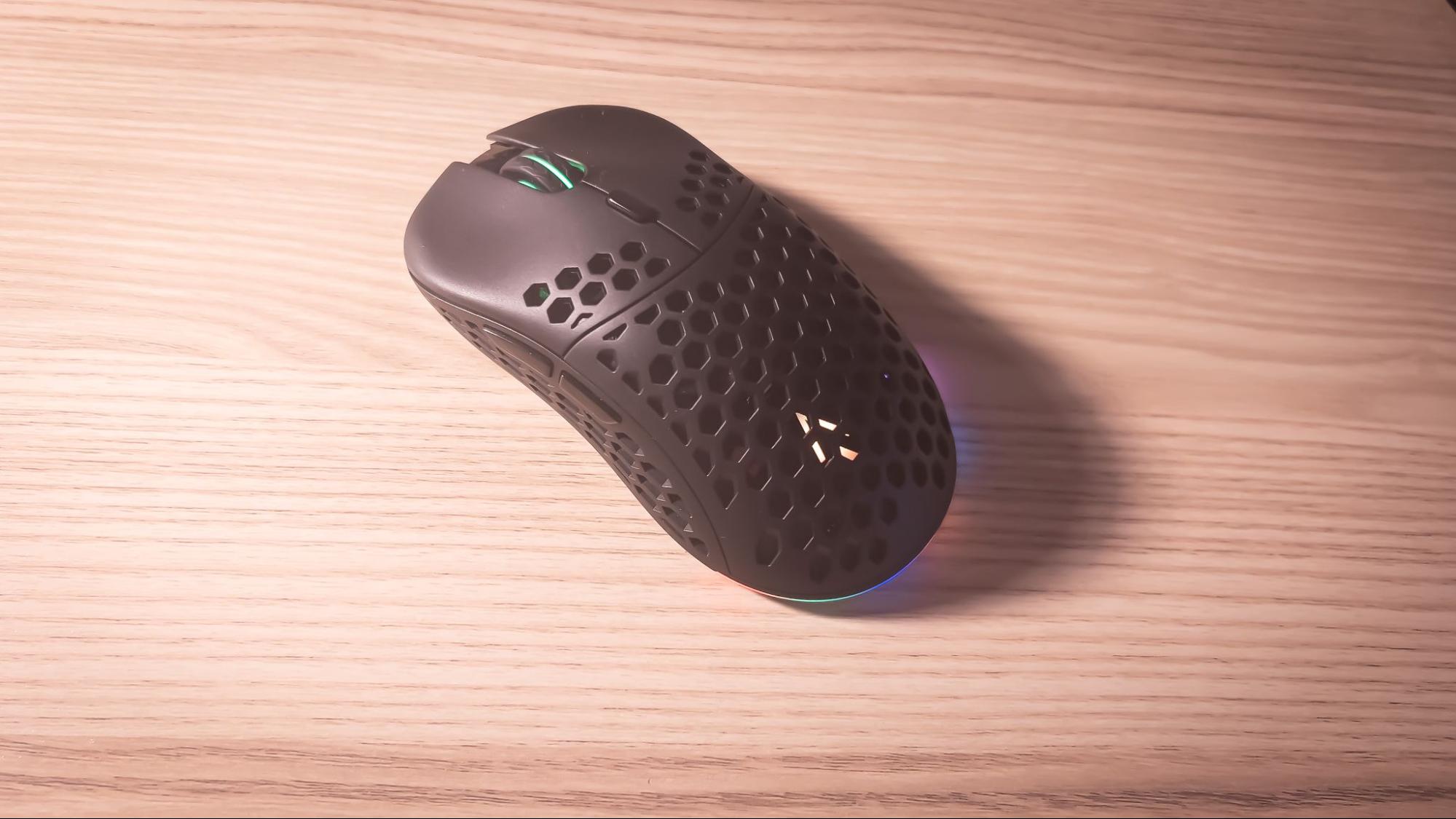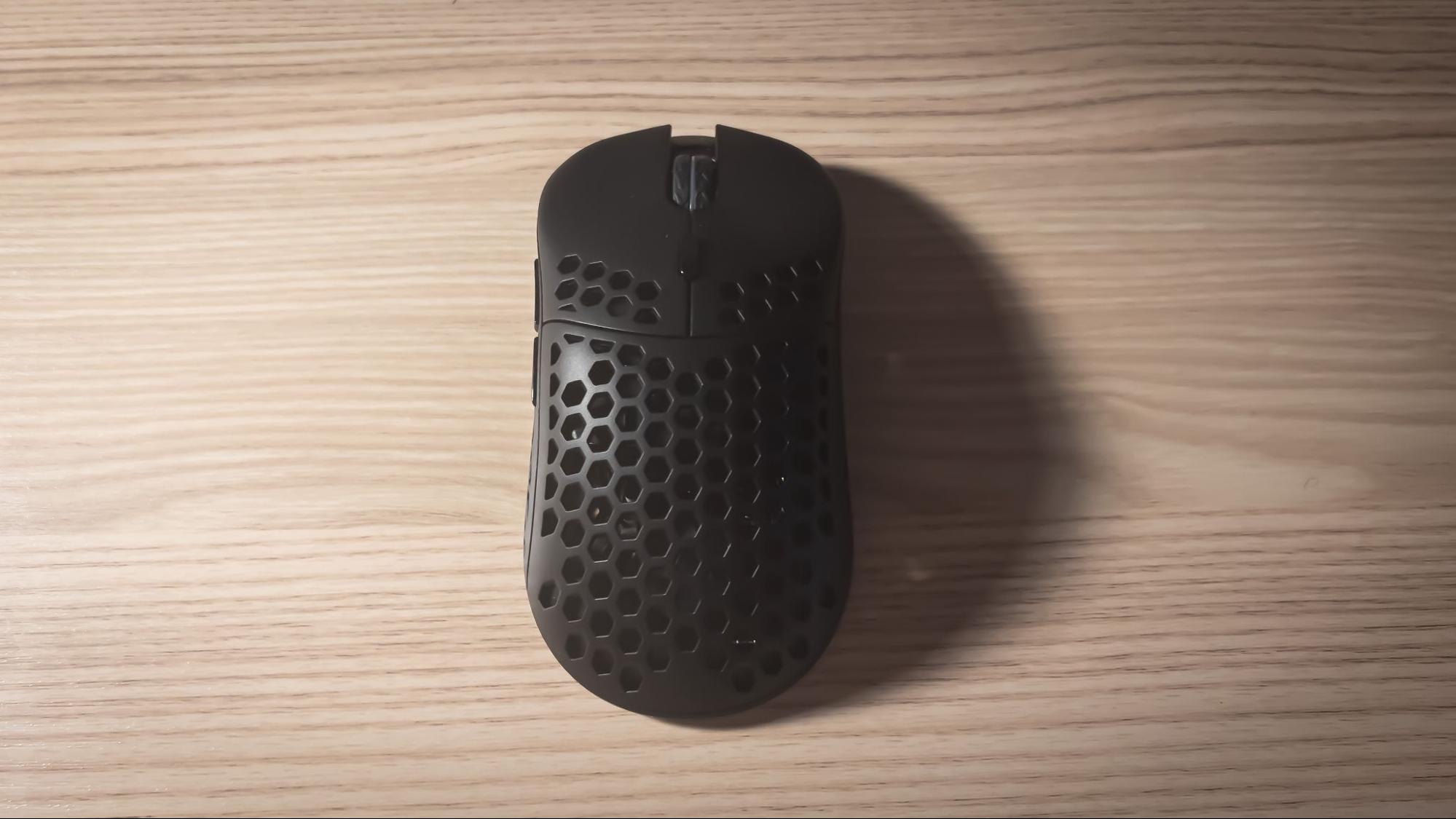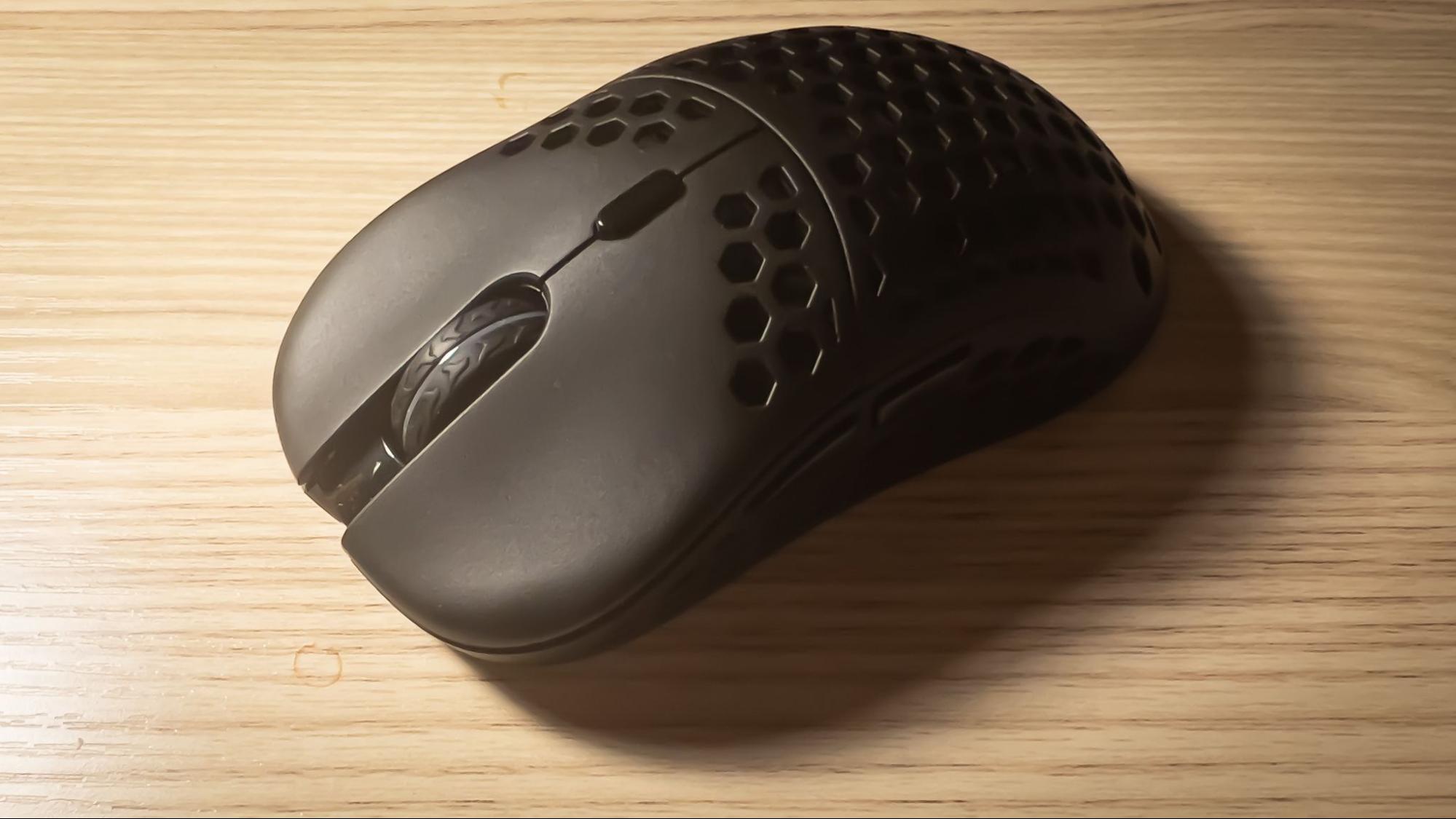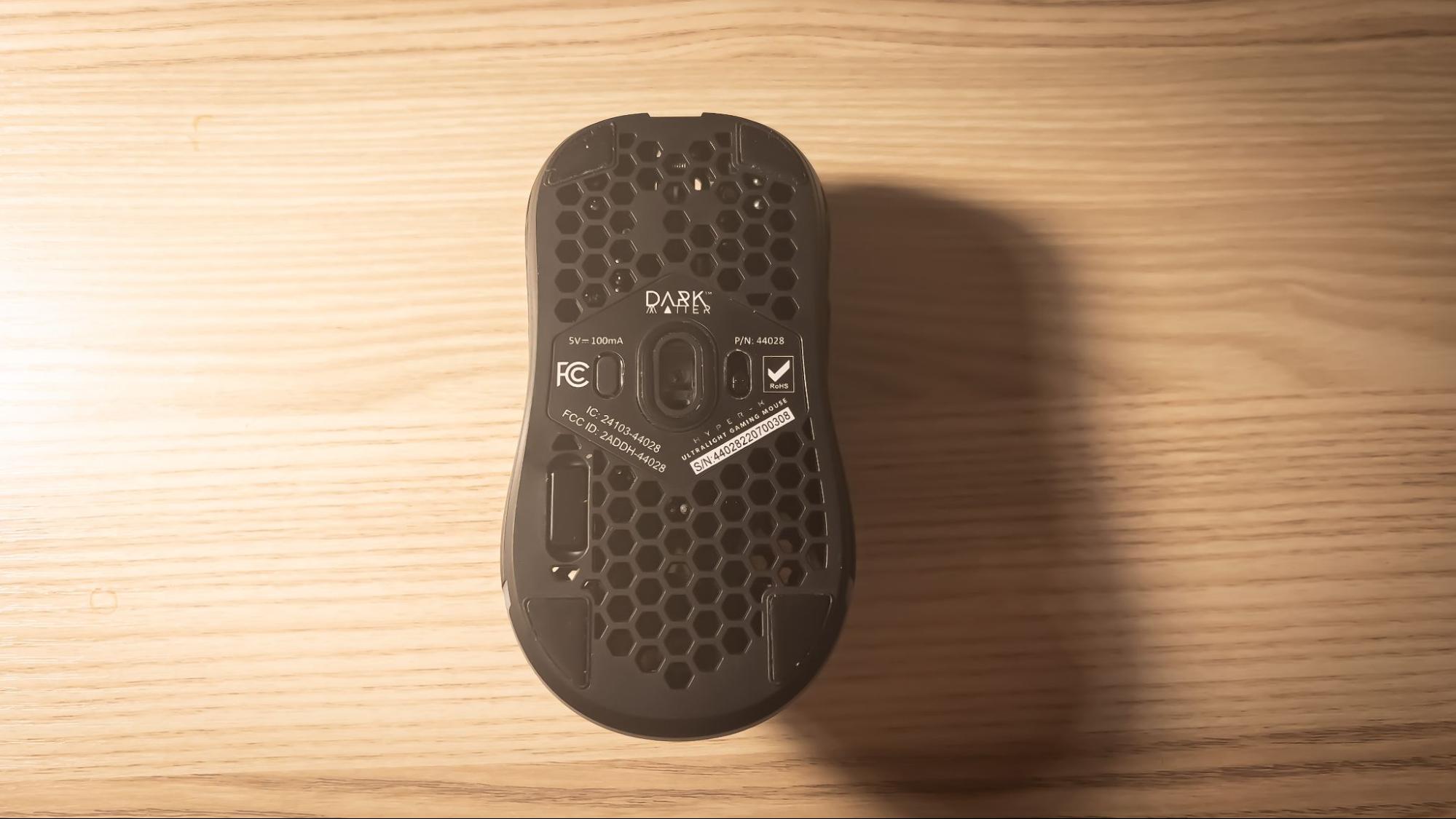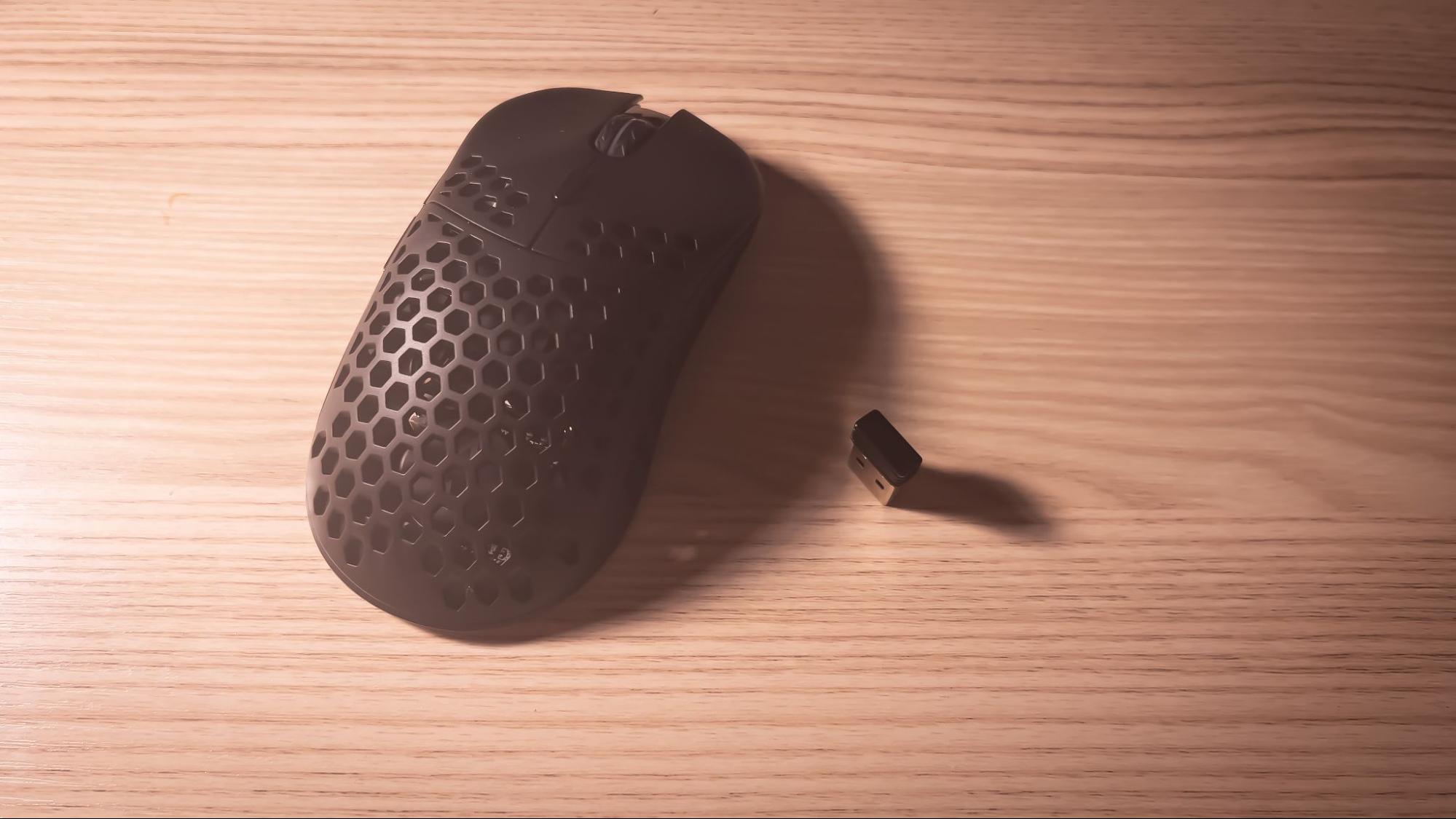Tom's Hardware Verdict
Despite its affordable price tag of $60, the Monoprice Dark Matter Hyper-K Wireless is uninspired and overpriced.
Pros
- +
Lightweight (70 grams)
- +
2.4 GHz wireless
Cons
- -
No PTFE skates
- -
Weak battery
- -
Overpriced
- -
Cheap construction
- -
DPI cannot be fine-tuned
Why you can trust Tom's Hardware
The market for gaming mice has blown up in recent years due to competitive gaming and support on the newest consoles. Almost every gaming peripheral company features a mouse with a honeycomb design to make it as light as possible. That's what we're seeing with the Monoprice Dark Matter Hyper-K Wireless.
The Monoprice Dark Matter Hyper-K Wireless is a wireless gaming mouse with a lightweight honeycomb design, and it’s fairly affordable with a retail price of $69.99. But even at this low price point, it’s disappointing; its uninspired design just can’t compete with other similarly-priced lightweight gaming mice.
Specs
| Sensor Model | PixArt PAW 3335 |
| Max Sensitivity | 16,000 |
| Polling Rates | 1,000 Hz |
| Programmable Buttons | N/A |
| LED Zones | 3 |
| Cable | 6 feet, braided |
| Connectivity | 2.4 GHz wireless, Bluetooth, wired (USB-C) |
| Measurements (L x W x H) | 126 x 66x 39 mm |
| Weight (excluding cable) | 70 grams |
| MSRP | $69.99 |
| Price at time of Review | $59.99 |
| Released | Nov. 2022 |
Design and Comfort of the Dark Matter Hyper-K Wireless
The Monoprice Dark Matter Hyper-K Wireless continues the ongoing trend of lightweight wireless mice with honeycomb designs and RGB lighting. The honeycomb design has become a cornerstone of lightweight gaming mice, because it provides structure while reducing weight. But I hate it. I have trypophobia, which is a fear of clusters or patterns of small holes — sea coral gives me the chills, for example. So does... honeycomb.
There are a lot of honeycomb mice on the market — the most notable is probably the Glorious Model O Wireless, which retails for around the same price ($79.99) and has software configuration options, unlike the Hyper-K. The Hyper-K Wireless’ DPI cannot be adjusted in any software, so the only options you have are the six baked-in presets that come with the mouse (the Hyper-K Wireless’ maximum DPI is also 16,000 — not up to par with other sensors on the market).
The mouse has six buttons, plus a clickable scroll wheel: right/left mouse buttons, two thumb buttons, one button behind the scroll wheel, and one button next to the sensor on the bottom of the mouse. Because the Hyper-K Wireless has no software support, none of these buttons are programmable. The button behind the scroll wheel is not, as you might expect, for controlling RGB or switching DPI — it’s for the polling rate, which is ridiculous. The mouse has a maximum polling rate of 1,000 Hz, which is pretty normal for a gaming mouse.
The two thumb buttons are set to go forward/backward and the button on the bottom of the mouse is the DPI switch. Also on the bottom of the mouse is a spot to store the 2.4 GHz wireless dongle, which is always an appreciated feature.
The lack of software support means the mouse’s RGB is non-configurable, but it can be toggled on and off with multiple positional options on the power switch. (The top position has both the mouse and RGB on. The middle position has the mouse on but RGB off. The bottom position shuts the mouse off entirely.)
Get Tom's Hardware's best news and in-depth reviews, straight to your inbox.
Performance of the Dark Matter Hyper-K Wireless
I’ve been seeing a lot of people post videos on TikTok showing off aim trainer scores, so I decided to try that with the Dark Matter Hyper-K Wireless. After a couple of warm-up rounds with 3D Aim Trainer, I scored 51% accuracy — which could be improved if the Hyper-K skates were of higher quality. Decent PTFE skates can be found on very cheap mice, such as the $30 Cooler Master MM71, so there’s no excuse for Monoprice not to include them here.
The Hyper-K Wireless lacks the bells and whistles of other gaming mice, but it does get the job done. It’s not, however, the highest-quality mouse within its price range. If you use a low DPI, you can hear the brittleness of the internals when you lift it, which worried me when thinking about its long-term durability. That said, it tracked well and clicks were accurate — I didn’t experience any double-clicking issues or drops in wireless connection in my testing.
Battery Life of the Dark Matter Hyper-K Wireless
Like the rest of the mouse, the Dark Matter Hyper-K’s battery life is subpar. Monoprice rates the Hyper-K’s 300mAh battery at 50 hours with RGB disabled — 50 hours isn’t exactly impressive, and that’s with RGB off. Monoprice doesn’t mention whether the 50-hour estimate is over Bluetooth or 2.4 GHz wireless.
Also, unlike most wireless gaming mice, this mouse does not have quick-charging. Instead, you’ll need to wait three hours for this mouse to charge up.
I’m not impressed by the Hyper-K Wireless’ battery life, because there are more reputable mice on the market that have five times the battery life and cost half the price, such as the Logitech G305 Lightspeed (though that doesn't have a rechargeable battery).
Bottom Line
The Monoprice Dark Matter Hyper-K Wireless is one of the least recommendable products I have ever reviewed. For $69.99, I want to see PTFE skates, customizable DPI, and maybe even some creativity. I’ve seen other generic-brand honeycomb mice on Amazon for $17 that have longer battery life and more impressive RGB.
If you’re looking for a wireless honeycomb mouse, I recommend the Glorious Gaming Model O wireless, which I own. If you don’t need something wireless, the Cooler Master MM720 and the Glorious Gaming Model O Minus are two of our favorites.

Myles Goldman is a freelance writer for Tom's Hardware US. He reviews keyboards and cases.
-
kanewolf Reply
It would be helpful if the word "Mouse" was in the title of this post. Without that there is no way to know what a "Dark Matter Hyper-K" is ....Admin said:Even at $69, the Monoprice Dark Matter Hyper-K Wireless isn't worth it with cheap construction and weak battery life.
Monoprice Dark Matter Hyper-K Wireless Review: $69 Is Too Much : Read more -
Friesiansam Given that, in order to maintain some structural integrity with all those holes, the shell is going to have to be thicker, any weight saving is going to be minimal. The saved weight will soon be replaced, as the mouse interior fills with detritus.Reply -
RichardtST I hate the perforated lightweight mice too. Ugly as heck. Plus, I don't want a light mouse. I want a nice hefty mouse with a dang PINKY LIP and rough surface on the righthand side so I can lift it without squeezing. Do mice designers not use mice? How hard is it to add a nice lip on the right side so my pinky doesn't slide off. Why do I have to squeeze the stupid mouse so tight to lift it? C'mon guys. Do better. I want my thumb and pinky to have something to get UNDER so I can lift with zero effort. It's not that hard...Reply -
g-unit1111 Why do so many new mice designs have a ton of holes in them? They're not going to make it point faster.Reply -
cryoburner ReplyBut I hate it. I have trypophobia, which is a fear of clusters or patterns of small holes — sea coral gives me the chills, for example. So does... honeycomb.
Just wait until a nest of spiders hatches in there and they come crawling out all over your hand.
(the Hyper-K Wireless’ maximum DPI is also 16,000 — not up to par with other sensors on the market)
How many people actually use those highest settings though? Even 16,000 DPI seems pretty much unusable for just about anything, and is advertised more as a marketing gimmick that isn't necessarily going to be relevant to the actual tracking performance of a mouse sensor. Most competitive gamers use sensitivity in the 400 to 1,600 DPI range, so it tends to be pretty irrelevant whether one mouse supports up to 10 times that amount, and another supports up to 20 times. It's often possible to run a mouse at a high DPI and turn down sensitivity in each game's settings, but not all games offer good sensitivity adjustments, and it's questionable whether one will see much benefit from doing that.
Having a button set to the polling rate is pretty ridiculous though. Like whoever had the job of setting up the DPI select button misunderstood what they were supposed to be doing. Polling rate is not a setting you typically change after initially setting up a mouse. : P
In any case, I don't think I would trust the wireless capabilities of any gaming mouse to provide a reliable, low-latency experience unless it was independently tested to be close to a wired connection, like Logitech's recent "Lightspeed" mice. Some budget or productivity-focused wireless mice tend to have rather poor wireless latency. -
DavidLejdar Reply
Competitive gamers usually play at even below 1080p though. And when someone else plays a RTS at 4K, the (e)DPI requirement there may differ. And someone with an ultra-wide screen (or multi-screen setup) may even want to configure different DPI for horizontal and vertical mouse movements. At least from own experience, with a 27inch screen at 1440p, with 400 DPI I would have to move the wrist to get the cursor on desktop from one screen-edge to the other (without lifting the mouse), and with 800 DPI it is almost a full swipe - and that isn't great when moving the cursor around a lot e.g. in a game such as Cities: Skylines.cryoburner said:...Most competitive gamers use sensitivity in the 400 to 1,600 DPI range...
Which isn't to say that I am using 10,000 DPI myself. But there are a number of settings, such as the Windows pointer speed, some may want to lower and have higher DPI instead, and such as using e.g. 5,000 DPI as base for RTS, while having low in-game sensitivity for a shooter (which has such a setting). So I wouldn't say it is just a gimmick, even if it surely isn't that important to many an user. -
cryoburner Reply
But this mouse can do 16,000 DPI, upward of ten times the commonly-used sensitivity settings, so to claim that makes it "not up to par" with sensors that offer even higher DPI options is a bit questionable. These companies are advertising higher DPI numbers just for the sake of looking better on a spec sheet. Even on an extended desktop across a pair of 4K displays, DPI set that high would be quite unwieldy. When moving the mouse one inch moves the cursor 16,000 pixels, it's going to be difficult to click on anything accurately.DavidLejdar said:So I wouldn't say it is just a gimmick, even if it surely isn't that important to many an user.
And while additional resolution might potentially improve mouse tracking slightly even at lower DPI settings, there's much more than just DPI that affects accuracy, and a sensor with higher DPI isn't necessarily going to be more accurate. -
jsmithepa If you have trypophobia, u should refrain from reviewing anything with a honeycomb. Then further down u recommended the Glorious Gaming Model O wireless which is another honeycomb, and just as expensive as the Hyper-K. Ur all over the place Mister.Reply
